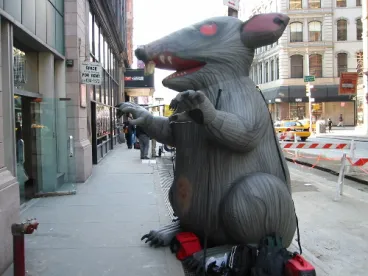Construction employers and general contractors are all too familiar with Scabby the Rat. The inflatable rat—appearing in sizes of up to a reported 30 feet tall—has infested construction job sites as part of trade union protest activities targeting employers that are not signatory to union labor agreements. Unions use the rat as an attention-grabber and a signal that an employer is using non-union labor. Construction employers will want to keep an eye on legal developments regarding the rat this year, including a recent Court of Appeals decision, and the potential for the National Labor Relations Board (NLRB) to modify its approach to disputes involving rats under federal labor law.
Over the past 30-plus years, there has been significant litigation over efforts to exterminate the rats. There have been challenges under federal labor law by targeted employers asserting that the practice of displaying inflatable rats on job sites is unlawfully coercive toward secondary employers that are on the same site but not involved in the union’s dispute with the targeted contract. There also have been First Amendment-based legal challenges to efforts by local government units to rid their communities of rats and other signs and displays on public property and rights-of-way, for both safety and aesthetic purposes.
The Seventh Circuit’s Decision
On February 14, 2019, in Construction and General Laborers’ Union No 330 v. Town of Grand Chute, the Seventh Circuit Court of Appeals issued an opinion affirming the right of the Town of Grand Chute, Wisconsin, to enforce its ordinance prohibiting such displays, and rejected the union’s arguments that the Town had violated the union’s First Amendment rights. In spring of 2014, Laborers Union Local 330 erected an inflatable rat on the median of a frontage road across from a car dealership where a non-union masonry contractor was performing construction work. The union also engaged in informational picketing at the site, asserting that the masonry contractor paid wages and benefits that were below area standards. The Town instructed the union to deflate the rat because it was in violation of its sign ordinance.
In response, the union sued the Town, asserting a violation of its First Amendment right to engage in the peaceful protest. In an earlier decision, the Seventh Circuit had agreed that the display of Scabby implicated First Amendment rights, but noted that a municipality may implement and enforce a nondiscriminatory ban of all private signs on public property and rights-of-way. Importantly, the court also noted that a facially lawful ordinance could result in First Amendment violations if it were enforced selectively, i.e., if the municipality applies content-based discretion and permits certain messages while prohibiting others.
In the February 14, 2019 decision, the court rejected the Laborers Union’s arguments that Grand Chute had engaged in unlawful, selective enforcement. The court found that the Town adequately demonstrated that it had responded to all complaints of other signs and had enforced the policy uniformly. According to the court, other signs the union pointed out as being allowed by the Town either were not found on public rights-of-way or were not prohibited by the ordinance because they were not affixed to the ground.
Going forward, this ruling may enhance the confidence of local governments in enacting and enforcing such regulations, which do not target labor messages but rather seek to prevent “eyesores” and structures that block traffic sightlines in general, regardless of their purpose or message. Construction employers facing union protest activity may consult with local authorities regarding inflatable rats or other displays placed on public rights-of-way, as they may be in violation of local regulations.
Peaceful Pest or Scourge To Be Exterminated?
Other challenges seeking to burst Scabby’s balloon may be coming under federal labor law. Under the Obama-era NLRB, the agency had likened the use of inflatable rats to peaceful, protected activities such as hand-billing and found that the rat did not have an unlawful, coercive effect. Many employers dealing with inflatable rat displays would disagree, asserting that the rat is a coercive symbol that has the same purpose and effect as unlawful picketing.
There are indications that current NLRB General Counsel Peter Robb may be looking for an opportunity to bring the inflatable rat and related issues before the Trump-era NLRB for a new review. In December, Robb reportedly ordered the reinstatement of a previously dismissed charge filed by an Illinois contractor against a labor union alleging unlawful coercion by the use of an inflatable rat. There also have been reports of “anonymous sources” within the NLRB stating that Robb is looking for appropriate cases for bringing the rat before the Board.




 />i
/>i
